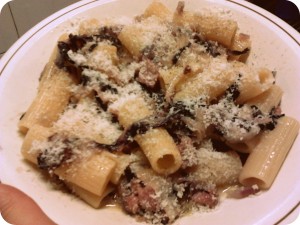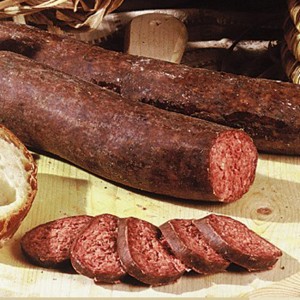Un salame italiano interessante e poco conosciuto: il CiauscoloAn interesting and little-known Italian salami: Ciauscolo
Ciauscolo : il salame tipico delle Marche , noto come “Il Salame che si spalma”
Storia :
Roseo, profumato, dal gusto saporito ma delicato, il Ciauscolo è il simbolo per eccellenza dei salumi marchigiani e maceratesi in particolare – infatti viene prodotto in ben 54 dei 57 Comuni della zona. Le caratteristiche che lo rendono unico sono la morbidezza e la spalmabilità. Ottenuto nel 2009 il riconoscimento dell’I.G.P. (Indicazione Geografica Protetta) è entrato nell’Olimpo dei salumi tipici italiani, ma le sue origini antichissime si perdono nel tempo: i più raffinati individuano l’etimologia del termine ciauscolo nel latino “cibusculum” , ovvero “piccolo cibo” , per sottolineare come questo salame si presti ad essere spalmato su fette di pane, crostini e bruschette , permettendo di preparare sfiziosi spuntini o antipasti .
Senza nulla togliere alle sue antiche origini, pare comunque più verosimile ( tanto più a chi conosce il dialetto maceratese e la sua simpatica fonetica ) che il nome di questo prodotto tipico sia mutuato da “lu ciausculu” , termine utilizzato nelle zone di macerata per indicare il budello gentile del maiale , con cui il ciauscolo e gli altri salami vengono insaccati .
Proprietà:
La celebre caratteristica di spalmabilità del ciauscolo è ottenuta con una ricetta e una tecnica di lavorazione che si sono tramandate di generazione in generazione in occasione della pista del maiale ( i giorni della mattanza del maiale e della preparazione degli insaccati ) , che insieme alla trebbiatura e alla vendemmia rappresentavano nella cultura rurale e contadina una vera e propria occasione di festa ( che farebbe probabilmente inorridire gli animalisti di oggi , ma che non è poi così crudele se calata nel contesto storico in cui si svolgeva ).
Le condizioni climatiche del territorio in cui si produce il ciauscolo sono legate alla presenza nella parte occidentale della catena appenninica umbro-marchigiana e, in quella orientale, del mare Adriatico. L’ambiente particolarmente umido e l’artigianalità della lavorazione contribuiscono all’unicità di questo salume morbido e aromatico.
La ricetta per la preparazione del ciauscolo :
L’impasto per la preparazione del ciauscolo è costituito da polpa di spalla, rifilatura di prosciutto, lonza, pancetta ( e in qualche caso anche cotica ) e viene tritato per tre volte sempre più finemente fino ad ottenere un impasto quasi cremoso ( che sarà tanto più morbido quanto più grasso è stato aggiunto ). A questo punto si aggiungono sale , pepe nero , vino e aglio pestato e si insacca nel budello naturale ( ‘ntillu ciusculu ) e inizia la fase di sfumatura : si tratta di una stagionatura di circa 3 settimane accanto ad un fuoco non troppo alto ( come i camini di una volta , in cui la brace veniva fatta ardere sotto la cenere mentre i contadini erano al lavoro nei campi).
Il ciauscolo di Fegato:
Una variante alla ricetta precedente prevede l’utilizzo di meno grasso e di fegato e carne di maiale , aggiungendo fra le spezie anche buccia d’arancia grattugiata e noce moscata. Il ciauscolo di fegato si presenta di colore più scuro e più saporito di quello tradizionale : può essere stagionato anche fino a 3 mesi ed ha quindi una consistenza maggiore.Ciauscolo: typical Marche salame, known as “The Salame that spreads”
History:
Rosy, fragrant, with a savory but delicate flavor, Ciauscolo is the symbol par excellence of the Marche and Macerata in particular salami – in fact it is produced in 54 of the 57 municipalities in the area. The characteristics that make it unique are the softness and spreadability. Obtained in 2009 the recognition dell’I.G.P. (Protected Geographical Indication) entered into the Olympus of Italian typical salami, but its ancient origins are lost in time: the most refined identify the etymology of the word ciauscolo in Latin “cibusculum” or “little food”, to emphasize that this salami is liable to be spread on slices of bread, crostini and bruschetta, allowing you to prepare delicious snacks or appetizers.
Without taking anything away from its ancient origins, still it seems more likely (especially to those who know the dialect of Macerata and his lovely phonetic) that the name of this typical product is borrowed from “lu ciausculu”, a term used to indicate in the areas of Macerata the pig’s intestine, with which ciauscolo and other sausages are bagged.
Property:
The claim to fame of ciauscolo spreadability is obtained with a recipe and a processing technique that has been passed down from generation to generation on the occasion of the runway of the pig (the days of slaughter and preparation of pork sausage), which together with the threshing and the vintage represented in the rural and peasant culture a real festive occasion (that would probably horrify animalists today, but that is not so cruel if dropped in the historical context in which took place). The climatic conditions of the area where it is produced ciauscolo are linked to the presence in the western part of the Marche and Umbria regions Apennine Mountains and , in the east, of the Adriatic Sea. The humidity environment and the craftsmanship of the work contribute to the uniqueness of this meat soft and aromatic.
The recipe for the preparation of ciauscolo:
The mixture for the preparation of ciauscolo is made from shoulder flesh, trimming of ham, loin, bacon (and in some cases also pork rind) and is chopped three times more and more finely until the dough is almost creamy (which will be so much softer as more fat has been added). At this point they add salt, black pepper, wine and crushed garlic and stuffed into natural casings (‘ntillu ciusculu) and starts the nuance phase: it is cured for about 3 weeks near a fire not too high (as chimneys once, where the embers was burning done under the ashes while the peasants were working in the fields).
Liver Ciauscolo:
A variant to the previous recipe involves the use of less fat and liver and pork, adding among the spices also grated orange peel and nutmeg. Liver ciauscolo looks darker and more flavorful than the traditional one: it can be aged for up to three months and therefore has a greater consistency.









Leave a comment